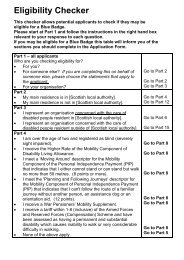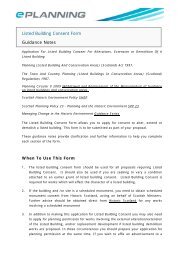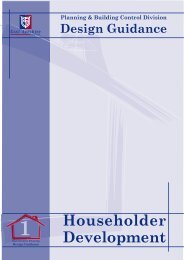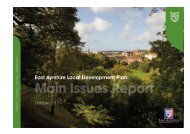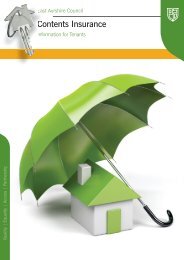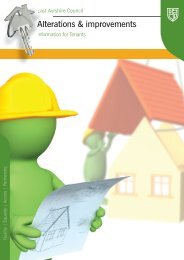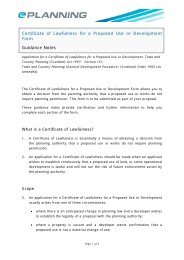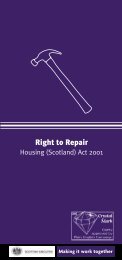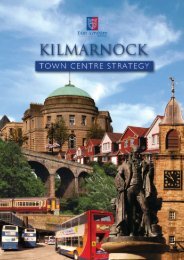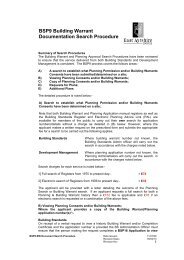EAST AYRSHIRE COUNCIL A PROPOSAL DOCUMENT
EAST AYRSHIRE COUNCIL A PROPOSAL DOCUMENT
EAST AYRSHIRE COUNCIL A PROPOSAL DOCUMENT
Create successful ePaper yourself
Turn your PDF publications into a flip-book with our unique Google optimized e-Paper software.
SUMMARY OF PROCESS FOR THIS <strong>PROPOSAL</strong> <strong>DOCUMENT</strong>1. Consideration by the Cabinet (Education)This Proposal Document has been issued as a result of a decision by theCabinet (Education) of East Ayrshire Council. This is to seek views on theproposals contained within this document.2. Proposal Document issued to consultees and published on the EastAyrshire Council WebsiteA copy of this document will then be issued free of charge to the consulteeslisted on the preceding page, and it will also be published on the Councilwebsite:www.east-ayrshire.gov.uk.3. Publication of advertisement in local newspapersAn advertisement will be placed in the relevant local newspapers and ifnecessary any national newspaper. In addition, there may beannouncements related to the Proposal process on the local radio station,West Sound / West FM.4. Length of Consultation periodAn announcement will be made through the Council’s website on the dayfollowing Cabinet approval and an advertisement will be placed in localnewspapers on 30 November 2012. The consultation will thereafter run untilclose of business on 25 January 2013, which includes a period of at least 30school days.5. Public meetingPublic meetings will be held, the details of which are given on the followingpage.6. Consultation with ChildrenIt is an explicit part of the process that the children of the schools affected bythis proposal document will be consulted by the Authority. The ScottishCommissioner for Children and Young People (SCCYP) has publishedguidance on this matter under the title “Participants not Pawns”. Thisguidance is available through the SCCYP website: www.sccyp.org.uk7. Involvement of Education ScotlandWhen the Proposal Document is published, a copy will also be sent toEducation Scotland by East Ayrshire Council. Education Scotland will alsoreceive a copy of any relevant written representations that are received by theCouncil from any person during the consultation period or, if EducationScotland agree, a summary of them. Education Scotland will further receive asummary of any oral representation made to the Council at the public meeting
that will be held and, as available (and so far as otherwise practicable), a copyof any other relevant documentation. Education Scotland will then prepare areport on the educational aspects of the proposal not later than 3 weeks afterthe Council has sent them all representations and documents mentionedabove. However, for the avoidance of doubt, the 3 week period will not startuntil after the consultation period has ended. In preparing their report,Education Scotland may enter the affected schools and make suchreasonable enquiries of such people there as they consider appropriate andmay make such reasonable enquiries of such other people as they considerappropriate.8. Preparation of Consultation ReportThe Council will review the proposal having regard to the Education ScotlandReport, written representations that it has received and oral representationsmade to it by any person at the public meeting. It will then prepare aConsultation Report. This report will be published in electronic and printedformats and will be advertised on the Council’s website, in local newspapersand, if necessary, any national newspaper. It will be available on the Councilwebsite and from Council Headquarters, public libraries in the vicinity of theaffected schools, local offices in the vicinity of the affected schools as well asthe affected schools, free of charge. Anyone who made writtenrepresentations during the consultation period will also be informed about thereport. The report will include:a record of the total number of written representations made during theconsultation period,a summary of the written representations,a summary of the oral representations made at the public meeting,the Authority’s response to the HMIE (Education Scotland) Report as wellas any written or oral representations it has received,a copy of the Education Scotland Report andany other relevant information, including details of any allegedinaccuracies and how these have been handled.The Report will also contain a statement explaining how it complied withthe requirement to review the proposal in light of the Education ScotlandReport and representations (both written and oral) that it receivedThe Consultation Report will be published and available for furtherconsideration for a period of 3 weeks.9. DecisionThis report together with any other relevant documentation will be consideredby the Cabinet (Education) of East Ayrshire Council who will come to adecision. This decision is then subject to the Council’s call-in procedures.10. Scottish Ministers Call-inShould the Council make a final decision to proceed with the closureproposal, it will require to notify the Scottish Ministers of that decision andprovide them with a copy of the Proposal Document and Consultation Report.The Scottish Ministers have a 6 week period from the date of that final
<strong>EAST</strong> <strong>AYRSHIRE</strong> <strong>COUNCIL</strong>DEPARTMENT OF EDUCATIONAL & SOCIAL SERVICESTHIS IS A <strong>PROPOSAL</strong> <strong>DOCUMENT</strong>Proposal :That subject to the outcome of this Proposal exercise:Education provision at St. John’s Primary School be discontinued witheffect from Friday 28 June 2013, or as soon as possible thereafter;That the pupils of St. John’s Primary School continue their educationat the present St. Patrick’s Primary School, with effect from Friday 16August 2013 or as soon as possible thereafter.Further:That the delineated area of St. Patrick’s Primary School should beextended to subsume the whole delineated area of St. John’s PrimarySchool.1. BACKGROUND1.1 East Ayrshire Council Vision for EducationCommunity Planning is about a range of partners in the public and voluntarysectors working together to better plan, resource and deliver quality servicesthat meet the needs of people who live and work in East Ayrshire.The Community Plan is recognised by all partners as the sovereign strategicplanning document for the delivery of public services in East Ayrshire over the12 years from 2003 to 2015 and sets out the overall vision for the local area.East Ayrshire will be a place with strong, vibrant communitieswhere everyone has a good quality of life and access toopportunities, choices and high quality services which aresustainable, accessible and meet people’s needs
1.2 Promoting Life Long LearningRecognising the importance of education the Council agreed on 28 June 2012that one of its key strategic objectives is to continue to raise attainment andmake our young people ready for the world of work.The provision of education is fundamental to economic regeneration of EastAyrshire and raising individual aspirations. East Ayrshire Council strives toensure that all its citizens are equipped with the appropriate skills for life andthe work place.1.3 Delivery of Curriculum for Excellence in East AyrshireCurriculum for Excellence is well embedded within all East Ayrshire Schoolsand seeks to achieve a transformation in education by providing a coherent,more flexible and enriched curriculum from 3 to 18. The curriculum includesthe totality of experiences that are planned for children and young peoplethrough their education, wherever they are being educated.Curriculum for Excellence aims to ensure that all young people developknowledge, skills and attributes for learning, life and work, which areencapsulated in the four capacities:‣ successful learners;‣ confident individuals;‣ responsible citizens; and‣ effective contributors.1.4 National and Local Influences(i)Scottish Government Commitment for the National School EstateThe Scottish Government commitment and vision for national school estatewas expressed jointly with COSLA, and resulted in the development of a newschool estate strategy which was published in 2009.This document, Building Better Schools: Investing in Scotland's Future, setsout national and local government’s shared vision, aspirations and principlesfor the efficient and effective management of the school estate and the keyaspirations for the school estate state:‣ “All children and young people will be educated in, and communityusers will use, schools that are 'fit for purpose' in terms of condition,suitability and sufficiency;‣ Schools are well-designed, accessible, inclusive learning environmentsthat inspire and drive new thinking and change and which support thedelivery of high quality educational experiences through Curriculum forExcellence;‣ Schools are integral parts of the communities they serve, with pupilsmaking use of community facilities and communities accessing schoolfacilities;‣ Schools accommodate and provide a range of services, activities andfacilities that make a difference to people's health and well being, to
sustaining economic growth and to the Strength and vibrancy ofcommunities;‣ A sustainable school estate whose design, construction and operationis environmentally and energy efficient; contributes directly to deliveringthe year-on-year reductions in greenhouse gas emissions introducedby the Climate Change (Scotland) Act 2009, which is resilient to theimpact of climate change and which leads by example in matters ofenvironmental performance;‣ A school estate that is efficiently run and that delivers maximum valuefor money;‣ A school estate which is flexible and responsive - both to changes indemand for school places and to learners' and teachers' requirementsand wishes, and where the beneficial impact of change is maximised bythorough Proposal and engagement with users and stakeholders”.This document has been framed taking account of these Scottish Governmentaspirations.(ii)(a)Local FactorsPupil RollsThe primary and secondary pupil roll within East Ayrshire has fallen by 2,51513.5% in the last decade. According to the General Registrar’s Office thenumber of children aged 0-15 in East Ayrshire is projected to fall by 4%between 2010 and 2035. It is recognised that this reduction is not evenlyspread across the Council area, with significant housing developmentsincreasing rolls in nearby schools, however it clear that the overall trend inprojected pupil rolls is downwards.Taking the most recent information available Table 1 (below) highlights thenumber of surplus spaces in the primary school and secondary school estate.Table 1:Primary and Secondary Pupil Rolls and School Capacitiesas at September 2012(A)SchoolPlanningCapacity(B)UsableSpaces(C)PupilRoll(D) = (B)-(C)SurplusCapacityPrimary 14,424 14,530 8,749 5,781Secondary 15,341 9,882 7,105 2,777Total 29,765 24,412 15,854 8,558The table highlights that there are 8,558 surplus spaces in the school estateand this equates to 12 two stream primary schools, with 14 classes and apupil roll of 480, or 3 secondary schools with a pupil roll of 900. In order toimprove building efficiency and reduce un-necessary expenditure the numberof surplus spaces must be reduced.
(b)School Estate Suitability and ConditionThe Cabinet of East Ayrshire Council renewed its endorsement for theestablished vision for its school estate on 27 June 2012. This vision willensure the delivery of Curriculum for Excellence in school buildings which aresuitable for that purpose. This vision further states:East Ayrshire Council’s Department of Educational andSocial Services : committed to providing choice, maximisingopportunity for all, developing the potential of individualsand meeting needs through inclusion”This statement covers every aspect of the Department’s work including themanagement and development of educational establishments. The Council’sSchool Estate Management Plan states that development and improvement inthe fabric of school buildings is a key component in the facilitation of thelearning and teaching process. Section 1.2 of the document also sets out asummary of the Council’s vision for our school estate. These are:“To not only provide facilities that meet the practicalities of good buildings butalso to create a positive impact on the learning experience and the value tothe community through:‣ Developing the ethos of inclusion;‣ Creating welcoming places for both students and Staff;‣ Facilitating a modern curriculum and learning experience;‣ Encouraging enhanced community use; and‣ Inspiring pride and ownership by communitiesHowever, in meeting these principles and aims the practicalities of the estateand determining investment strategies in line with the Council’s AssetManagement Plan the Council also requires to:‣ Achieve an average occupancy level of 85% of capacity;‣ Address maintenance issues and condition;‣ Meet statutory requirements including DDA legislation;‣ Consider security implications; and‣ Improve property flexibility and extended use.”The continued upgrading of the school estate is seen as being essential inmeeting the key strategic theme of raising educational attainment andpreparing our young people for the world of work.East Ayrshire Council is proud of the work undertaken to ensure that youngpeople are educated in excellent school buildings, however there is morewhich needs to be done to further improve our school estate and ensure allyoung people are given the opportunity to learn in a building which meets theCouncil’s objectives.
(c)East Ayrshire Council’s Transformation StrategyThe Council of East Ayrshire agreed the Transformation Strategy at itsmeeting of 28 June 2012. Paragraph 19 of the covering report set out the 10key strategic imperatives and stated:“ ix Asset Management – A significant element of the cost of councilservices relates to the use of physical assets. These need to be employed tomaximum effect and surplus and underperforming assets disposed of. TheAsset Management Strategy needs to be reviewed to ensure that it isappropriately re-aligned to reflect changes to strategic priorities. Targetoccupancy, usage, accessibility levels and unit costs should be establishedfor each category of building and the Transformation Strategy shouldthereafter include actions to achieve these targets.The Schools Estate Management Plan has already set a total schooloccupancy target of 85%. The Scottish Futures Trust is working on an initialtarget reduction of 25% of the national estate. These targets should beadopted by the Council and pursued relentlessly with regular reports toCabinet on their achievement. New capital projects should be expected todemonstrate net revenue savings over the lifetime of the asset.”The proposal contained within this document meets the stated objectives inrelation to the Council’s Transformation Strategy as it relates to buildings.2. <strong>PROPOSAL</strong>2.1 Taking the context set out in section 1 (above), it is therefore proposed that:Proposal :That subject to the outcome of this Proposal exercise:Education provision at St. John’s Primary School be discontinued witheffect from Friday 28 June 2013, or as soon as possible thereafter;That the pupils of St. John’s Primary School continue their educationat the present St. Patrick’s Primary School, with effect from Friday 16August 2013 or as soon as possible thereafter.Further:That the delineated area of St. Patrick’s Primary School should beextended to subsume the whole delineated area of St. John’s PrimarySchool.
3. PRESENT POSITION3.1 ST. JOHN’S PRIMARY SCHOOL3.1.1 St. John’s Primary School provides denominational primary education topupils from Cumnock and the surrounding area with children attending fromCronberry, Logan, Lugar, Muirkirk, Ochiltree and Skares. As at 27 August2012 there were 31 children presently attending, with no pupils attending byway of placing request. Of the 31 pupils attending, 7 are from faithbackgrounds other than Roman Catholic, unknown or of no faith, and 5 pupilsare assessed as having additional support needs.Appendix 1 (attached) shows the present school delineated areas for both St.John’s Primary School and St. Patrick’s Primary School. The school sites forSt. John’s Primary and St. Patrick’s Primary School are attached as Appendix2.3.1.2 The planning capacity of a school is calculated by dividing the total area ofteaching rooms by the space allocation per child (1.7m²). The workingcapacity takes account of maximum class sizes, for example, compositeclasses which are limited to 25 pupils. Based on the Council’s spaceallocation the classrooms could accommodate 231 pupils; however, due tomaximum class sizes for composite classes the capacity of these rooms islimited to 25 each. Therefore, while the planning capacity of the school is231, the working capacity is 215. As at census in September 2012, therewere 31 pupils enrolled and therefore the school has an occupancy rate of13.4%The school structure presently is made up of 2 composite classes made up asfollows :P1/2/3/4 with 12 pupilsP5/6/7 with 19 pupilsThe year stage breakdown is:P1 - 4P2 - 3P3 - 1P4 - 4P5 - 6P6 - 6P7 - 7Historical and projected pupil roll data for St. John’s Primary School and St.Patrick’s Primary School is attached at Appendix 3. This data shows that theroll of St. John’s Primary School has been falling over the last decade, withpupil numbers unlikely to increase significantly above their present level.3.1.3 St. John’s Primary School has an entitlement to 2.85 full-time equivalent(FTE) Teaching Staff. The school is visited once weekly by a member of Stafffrom the <strong>EAST</strong> (learning support) service, and also twice weekly by theHearing Impairment service. The Bilingual Support service visits once a week.
The school also has support from the following ancillary staff :-‣ 1 Classroom Assistant;‣ 1 Senior Clerical Assistant (25 hours);‣ 1 Janitor / Cleaner (37 hours);‣ 1 Catering Assistant (10 hours); and‣ 4 Cleaners (34.87 hours).3.1.4 The St. John’s Primary School building is a single storey building with a flatroof. It offers semi-open plan accommodation in accommodation of a designthat was common to schools constructed in the 1960s and 1970s. This typeof design offers flexibility in teaching and learning approaches since itcombines both closed classrooms and open areas. Over recent years, therehas been an extensive amount of refurbishment work undertaken, includingwindow replacements and the installation of modern cladding. This hasconsiderably enhanced the appearance of the school, and there are no knownsignificant issues with the fabric of the building, which presents as bright andattractive. The School Estate Management Plan submitted to Cabinet on 27June 2012, identified the school buildings as being rated “B” for both conditionand suitability.Because of the falling school roll there is substantial availability of space thathas been expanded into by the school. Surplus accommodation has beenabsorbed by the deployment of Authority services such as the <strong>EAST</strong> team(formerly Network Support and Youth Strategy) to St. John’s Primary School.This service occupies 2 rooms on a peripatetic basis, although both roomshave been used infrequently in the recent past. Additionally one room hasbeen identified by the Authority as potential storage space.3.1.5 Within St. John’s Primary School, the following accommodation is offered:‣ 1 gym hall;‣ 1GP room;‣ 1 ICT room;‣ 8 classrooms;‣ 1dining hall;‣ 1 music room(partition wall to dining hall);‣ 1 meeting room( partition wall to dining hall);‣ 1 staffroom; and‣ 1 administrative office.3.1.6 The present accommodation of St. John’s Primary School building presents anumber of issues:‣ The accommodation is significantly under-occupied, giving rise tounnecessary running costs; and‣ The building is not fully energy-efficient.
3.1.7 Most Recent Education Scotland (HMIe) ReportSt. John’s Primary School was last inspected in 1998. The findings of thatinspection are therefore of limited value in relation to the present proposal.The main findings at that time were:“Key Strengths‣ The spacious, well used accommodation and the very good range ofresources to support learning and teaching.‣ The very effective partnership with parents.‣ The very positive ethos in the school.‣ The development of detailed educational plans for particular pupils withdifficulties in learning.‣ The hard work and commitment of the head teacher and his staff.Main Points for ActionThe school and education authority should act on the followingrecommendations.‣ The programme for writing should be fully aligned with national advice.‣ National tests should be introduced to confirm teachers’ ownassessments of attainment in writing.‣ The school should ensure that there is a consistently high level ofchallenge in pupils’ work and that tasks are better matched to pupils’attainment levels.‣ The head teacher should develop quality assurance procedures toenable him to monitor pupils’ progress and attainment more effectively.‣ Planning and assessment procedures should be agreed to ensuregreater consistency in approach across the school”.HM Inspectors visited the School in May 2000 to evaluate progress made inresponding to the main points for action in the report and noted that the schoolhad made good progress in addressing the main points for action in the report3.1.8 Following the retiral of the substantive Head Teacher of St. John’s PrimarySchool in August 2010, the Authority received only one application and wasunable to form a viable interview leet for the post. In accordance withprocedures agreed with the teaching unions, the Head Teacher of St.Patrick’s Primary School was appointed to the joint headship of St. Patrick’sand St. John’s Primary Schools with effect from 5 January 2011.3.2 ST. PATRICK’S PRIMARY SCHOOL3.2.1 St. Patrick’s Primary School provides denominational primary education topupils from Auchinleck and the surrounding area including Catrine, Drongan,Sorn and Mauchline. Appendix 1 shows the present school catchment areasfor both St. John’s Primary School and St. Patrick’s Primary Schools. Theschool sites for St. John’s Primary and St. Patrick’s Primary School areattached as Appendix 2. At census in September 2012, 73 children wereenrolled at St. Patrick’s, with 2 being enrolled by virtue of placing request and10 of the children were assessed as having additional support needs.
3.2.2 The planning capacity of a school is calculated by dividing the total area ofteaching rooms by the space allocation per child (1.7m²). The workingcapacity takes account of maximum class sizes, for example, compositeclasses which are limited to 25 pupils. Based on the Council’s spaceallocation the classrooms could accommodate 231 pupils; however, due tomaximum class sizes for composite classes the capacity of these rooms islimited to 25 each. Therefore, the planning capacity of the school is 231, witha working capacity of 143. There are currently 73 pupils enrolled andtherefore the school has an occupancy rate of 31.6%.The school structure presently has 4 classes made up as follows :P1/2 – 13 pupilsP2/3 – 18 pupilsP4/5 – 18 pupilsP6/7 – 24 pupilsThe age distribution of children within these classes is:P1 – 5P2 – 15P3 – 11P4 – 8P5 – 10P6 – 12P7 – 123.2.3 Historical and projected pupil roll data for St. John’s Primary School and St.Patrick’s Primary School is attached at Appendix 3. This data shows that theroll of St. Patrick’s Primary School has been falling over the last decade, withpupil numbers unlikely to increase significantly above their present level. St.Patrick’s Primary School takes children from 5 nurseries and therefore it is notknown with certainty what the likely future P1 enrolment numbers will be.3.2.4 St. Patrick’s Primary School has an entitlement to 4.89 full time equivalent(FTE) teaching staff. In addition, the school has also received an allocation ofan additional 0.7 probationer for academic session 2012 - 2013.The school is also supported by the following ancillary staff :‣ 1 Classroom Assistant (27.5 hours)‣ 1 Senior Clerical Assistant (30 hours)‣ 1 Janitor (37 hours)‣ 2 Catering Assistants (20 hours),‣ 2 Cleaners (34.1 hours).3.2.5 In accordance with procedures agreed with teaching unions, the HeadTeacher of St. Patrick’s Primary School was appointed to the joint headship ofSt. Patrick’s and St. John’s Primary Schools from 5 January 2011.3.2.6 The St. Patrick’s Primary School building is a two storey building with a flatroof. It offers accommodation to a design that was common to schools
constructed in the 1960s and 1970s. This type of design offers flexibility inteaching and learning approaches combining closed classrooms with openareas such as the hall. Because of the falling school roll there is substantialavailability of space that has been expanded into by the school. The SchoolEstate Management Plan submitted to Cabinet on 27 June 2012, identifiedthe school buildings as being rated “B” for both condition and suitability.3.2.7 Within St. Patrick’s Primary School, the following accommodation is offered:‣ 1 x dinner hall/gym hall;‣ 7 x classrooms; which include:• 4 Learning bases• 1 x ICT suite;• 1 x music/drama/GP/ Learning Support room;• 1 x structured activity room;‣ 1 x library/store;‣ 1 x staff room;‣ 1 x Head Teacher’s office;‣ 1 x administration office; and‣ 1 x medical/additional admin room3.2.8 The present accommodation of St. Patrick’s Primary School building presentsa number of issues:‣ The overall design of the school is for a school of 1960s vintage anddoes not incorporate the design principles of a modern primary schoolsuch as green design principles;‣ A number of the building components are in need of replacement orrenewal, although the building is rated as “B” for condition; and‣ The building is not fully energy-efficient.3.2.9 Most Recent Education Scotland (HMIe) ReportSt. Patrick’s Primary School was last inspected in 2003. Therefore, thefindings of that inspection are of limited value in providing information relevantto this proposal. However, the inspectors at that time did, as part of thenormal inspection routine comment in a little detail on accommodation issues.The accommodation of the school at that time was assessed as “fair”following which the authority did embark on a phased refurbishmentprogramme. The full comment in the inspection report was:“Overall, the quality of the accommodation was fair. The spacious buildingprovided a good learning environment but the exterior was in need ofrefurbishment. There were health and safety concerns surrounding drainageand subsidence problems with the grassed play area. Classrooms were of agood size and attractively laid out. The main Strength was the range ofspaces available. Facilities included catering on the premises, a parents’room, a library, a general purposes room and a large gymnasium which wasalso used for dining and assemblies. There were very good storage spacesfor classroom resources, though not for playground equipment. Displays ofpupils’ work enhanced corridors and classrooms. The hard play area wasmarked out for a range of games. The school had sensible arrangements in
place for pupils’ security. Improvements for overnight security were underconsideration. “ (HMIE, 2003)4. THE OPTIONS4.1 There are three possible options for St. John’s Primary School :Option 1:Option 2:Option 3:No ChangeClose St. John’s Primary School and transfer the pupils to thepresent St. Patrick’s Primary School. The catchment area of St.John’s Primary School would subsumed into that of St. Patrick’sPrimary School.Close St. John’s Primary School with the pupils from St Patrick’sPrimary School transferring to a new St. Patrick’s PrimarySchool which will be located in the current St. John’s PrimarySchool buildings. The present catchment area of St. John’sPrimary School would subsumed into that of St. Patrick’sPrimary School.The implications of these various options are explained below.5.2 Option 1: No ChangeAdvantagesMaintains individual local Roman Catholic Primary Schools in Cumnockand Auchinleck.Reduces the travelling distance required to be undertaken by somechildren when compared to Option 3 (Closure of St. John’s and pupiltransferred to St. Patrick’s Primary School).Maintains access to Council facility within the Barshare Community.Disadvantages Children of both establishments would continue to have a limited peergroup. Both schools would have a lower level of staffing and resources, withreduced flexibility and advantages of economies of scale. Result in unnecessary revenue and capital costs which woulddisadvantage children of both schools and other children in East Ayrshire. Would not offer opportunity to address falling rolls in both St. John’sPrimary School and St. Patrick’s Primary School and associated issues,such as the under-occupancy issue at both establishments.EvaluationWhile this option would offer the sense of security that comes with a “nochange” position, the issues of a small peer group for children, managementrecruitment and the uncertainty caused by falling rolls would remain. Anopportunity to reduce costs, with the general benefits of better resourceallocation would be lost, as would the advantages of economies of scale.
5.3 Option 2: Close St. John’s Primary School and transfer the pupils to St.Patrick’s Primary School. The catchment area of St. John’s PrimarySchool and St. Patrick’s Primary School would be merged.AdvantagesChildren would have a larger peer group, which will deliver enhancedopportunities for learning and personal and social education.Strengthens and safeguards Catholic educational provision in theCumnock and Auchinleck area.Opportunities for revenue and capital savings with resulting benefits forchildren at St. Patrick’s Primary School, St. John’s Primary School andthroughout the Authority.Would release the St. John’s Primary School site for other uses or togenerate a capital receipt.DisadvantagesWould reduce the number of Council facilities available to the Barshareand Cumnock communities.Some children will have further to travel to attend St. Patrick’s PrimarySchool.EvaluationAlthough this option would result in the highest level of change, it will generatethe largest educational benefits with the maximum beneficial impact onrevenue and capital expenditure.5.4 Option 3: Close St. John’s Primary School with the pupils from StPatrick’s Primary School transferring the pupils to a new St. Patrick’sPrimary School which would be located in the current St. John’s PrimarySchool buildings. The present catchment area of St. John’s PrimarySchool and that of St. Patrick’s Primary School would be merged.AdvantagesChildren would have a larger peer group, which will deliver enhancedopportunities for learning and personal and social education.Strengthens and safeguards Catholic educational provision in theCumnock and Auchinleck area.Opportunities for revenue and capital savings with resulting benefits forchildren at St. Patrick’s Primary School, St. John’s Primary School andthroughout the Authority.Would release the St. Patrick’s Primary School site for other uses or togenerate a capital receipt.DisadvantagesWould reduce the number of Council facilities available within theAuchinleck community.
A greater number of children will have further to travel to attend thepresent St. John’s Primary School site than would have to under Option 2.This would increase the cost of pupil transport.EvaluationAlthough this option would result in many of the benefits of Option 2, a greaternumber of children will be required to travel to a new St. Patrick’s PrimarySchool if it is relocated to the existing St. John’s Primary School buildings.5.5 PREFERRED OPTION AND EDUCATIONAL BENEFITS STATEMENT5.5.1 The Recommended OptionThe maximum benefits will come from Option 2 above. It is thereforeproposed that St. John’s Primary School should close and the children shouldtransfer to St. Patrick’s Primary School in Auchinleck, which would then havea new and enlarged delineated area. This new delineated area would be theresult of the joining of the present St. John’s and St. Patrick’s PrimarySchools.The educational benefits for the proposal are set out below.5.5.2 Educational Benefits StatementiThis Educational Benefits Statement has been prepared having regard to theGuidance and Explanatory Notes published by the Scottish Government inassociation with the Schools (Consultation) (Scotland) Act, 2010 and whichare available for reference at the following websites, respectively:www.scotland.gov.uk/Resource/Doc/91982/0097130.docwww.oqps.gov.uk/legislation/acts2010/en/aspen_20100002_en.pdf“An education authority shall endeavour to secure improvement in the qualityof school education which is provided in the schools managed by them; andthey shall exercise their functions in relation to such provision with a view toraising Standards of education.”iiAs required by the Schools (Consultation) (Scotland) Act, 2010, this EBS iswritten from the perspective of benefits, if the proposal is implemented. It isrecognised by the Authority that the move from the present St. John’s PrimarySchool building to the present St. Patrick’s building means that children will begoing to accommodation which is of similar age and design features to theirpresent school. The main benefits therefore relate to the roll size of St.Patrick’s Primary School after the proposal is implemented.Benefits for the Pupils of St. John’s Primary School and St. Patrick’sPrimary SchooliiiAll schools are expected to be implementing the features of the Curriculum forExcellence from August 2010. The presence of a greater number of childrenin the school, and at individual year stages, will mean that there are improvedpossibilities for children to come in contact with different ideas. Most
obviously, there will be an increased range of communities represented ineach teaching group, including those from the villages in the rural hinterland.This will bring a greater variety of experiences and backgrounds into theclassroom.ivvviviiOpportunities will be more easily created for children to discuss, learn fromone another and to develop an openness and tolerance for new ideas. Withthese greater opportunities the 4 capacities of successful learners, confidentindividuals, effective contributors and as responsible citizens will beenhanced. Inevitably, a larger establishment exposes children to a morevaried set of relationships and organisational arrangements, thereby creatingopportunities that will allow them to be better able to cope with variety and thepace of change with confidence.The quality of the curriculum offered in the enlarged school will be equivalentin terms of content to that found presently in the separate establishments.However, there will be improved flexibility in its delivery arising from thegreater number of learners, a greater number of staff being available and thehigher level of resourcing which is a feature of larger schools. This arisesfrom the Authority policy of allocating staffing and finances to establishmentsbased on a formula which is directly related to pupil numbers. This higherlevel of staffing gives the Head Teacher greater flexibility in deployment ofteachers to meet the needs of the establishment. It also, all other thingsbeing equal, increases the chances of a greater range of staff skills beingavailable to children. In this way children’s general learning needs can betterbe met. Ultimately, this will be manifest in a curriculum with greater potentialfor depth, breadth, challenge and enjoyment since there will be a greaterrange of skills and interests to deliver it, supported by a higher level ofresourcing. Greater challenge can also be introduced since there is greaterscope for Staff to compare pupil work and standards reached; the childrenthemselves will learn from their peers and there will be increasedopportunities to share work, their experiences and how they have overcomebarriers to learning. The rationalisation of the number of establishments willease planning of transition and curricular coherence both between associatedprimary schools, and between the primary and secondary school. While thesemi-open plan nature of St. John’s facilitates movement between learningbases and specialist areas, allowing the promotion of interdisciplinary learningthe conventional classrooms in St Patrick’s offer individual staff someflexibility in learning approaches.Greater pupil numbers also allows the Authority to make more effective use ofStrategic groups of Staffing such as the <strong>EAST</strong> team and the teams whichsupport sensory impairment. Health professionals are also better placed toallocate their time to meet groups of children where numbers are higher. Thehigher numbers of children also gives more flexibility through the formation ofgroups supported by ancillary Staff, teaching Staff and visiting specialists. Italso allows better for peer support and therefore there are clear benefits tochildren with additional support needs.Parents are sometimes anxious about the impact that a larger school mighthave on issues such as the care and welfare of children, its ethos and thepersonal and social development of children. The expectation on all schools,irrespective of size is that they will actively promote a positive ethos and put
the care and welfare of children first. It would therefore be expected that allchildren would be known to Staff and most importantly to know to whom theycan talk if they have a problem. This work is supported by the expectationthat an active structured, stimulating and relevant programme of personaldevelopment will be available to children. This latter also includes the time oftransition. Special measures will be emphasised as part of the transition planthat will facilitate the two schools coming together. These measures willinclude:‣ Opportunities for parents and children to visit the new campus.‣ Opportunities to meet Staff and children at the receiving school‣ Joint planning between teachers on matters such as the curriculumassessment and reporting.‣ Joint work between the Parent Councils‣ Exchange of learning information in advance of the merger.‣ Buddying and mentoring systems‣ Joint events such as shows and sports days‣ Team events‣ Staff supervision of playgrounds and games.‣ Involvement in design, if appropriate, of school uniform or logo‣ Work by visiting agencies including any shared chaplaincy.viiiThe proposal involves consideration of two schools of similar age, withrelatively modern designs. The lay-out of the schools make them relativelyaccessible for children with mobility problems and sensory impairment. Bothcampuses are accessible for transport. The Authority has clear policies onboth equal opportunities and inclusion and these would apply to the newlymerged school.The Benefits for Children Likely to Attend the SchoolixNeither school has a nursery class. The existence of a single, larger andstronger denominational school offering a wider range of educationalexperience, and with stability in Head Teacher appointments should bereassuring to parents planning on denominational education. Children whowill attend the school will have access to all of the facilities, provision andbenefits highlighted in the paragraphs above. It is the case that it is likely thatthe newly enlarged school will require to liaise with a greater number ofnurseries than is done at present by St. Patrick’s or St. John’s singly.Management arrangements will take account of this requirement.Benefits for other Users of the School Including Adults and CommunityUsersxThe pattern of community use is described elsewhere in this proposaldocument. The newly merged school will be accessible to those adults andgroups that wish to use the premises. Where any group uses the present St.John’s premises it will be offered lets either at St. Patrick’s Primary School orat other suitable Council premises in the Cumnock area. It is not anticipatedthat there will be any difficulties in relocating groups to alternative facilities.Benefits for Other Pupils in the Authority Area
xiThis proposal will result in resources being freed for the general advantage ofthe pupil population of East Ayrshire. This is particularly important in a time ofvery scarce resources, when without the financial savings accruing from thisproposal, other options would come into operation leading into a generalreduction in Staffing or resource levels. The removal of a building with itsassociated infrastructure costs will allow asset management attention andresources to be better concentrated on the remaining establishments to thebenefit of the young people.Effect on St. Patrick’s Primary SchoolxiixiiiSt. Patrick’s Primary School is also a relatively small school, with a small Staffgroup. This proposal will strengthen the viability of the school, and will enrichit by the addition of more pupils and Staff. There is sufficient space for theadditional children and Staff, while none of the existing community willexperience any reduction in the level of provision available to them.In terms of extra-curricular activities St. John’s Primary School runs thefollowing out of school clubs :-Craft Club (Tuesday)Glee Club (Thursday)xivIn the current academic session the St. Patrick’s Primary School pupils areoffered the following activities :Breakfast Club (Monday to Friday)Fun Music (Tuesday)Guitar (Thursday)Football (Friday)xvxviEvery effort would be made to encourage the continuation of theseprogrammes, married to the provision presently offered at St. Patrick’sPrimary SchoolThe pattern of lets for St. John’s Primary School is shown below.Number of Lets: St. John’s Primary SchoolLet taken by 2011/122012/13(1 April –31 August)Cumnock Christian Fellowship 1 2Head Teacher 2 1Boys Singing / SongwritingSummer School 12Cumnock Area Vocal School 3St. John’s Primary SchoolParent Council 2 2Leisure Development 3Other 7 2Total 12 25
Number of Lets: St. Patrick’s Primary SchoolLet taken by 2011/122012/13(1 April –31 August)Head Teacher 9 2East Ayrshire Housing Service 2 4Leisure Development 1 12SHOUT Club 10 10St. Patrick’s Primary SchoolParent Council 3 2Fusion School of Dance 12Other 2Total 25 445.5.3 Under Section 12 of the Schools (Consultation) (Scotland) Act 2010, andfollowing Scottish Government classification of schools it can be confirmedthat St. John’s Primary School is a categorised as an urban school.(a)Alternatives to the Closure ProposalThe alternatives to closure that have been considered are as follows :-(i)(ii)(b)(i)Retention of St. John’s Primary School on its current site;A merger of St. John’s Primary School and St. Patrick’s Primary School, into anew St. Patrick’s Primary School which would be located in the existingbuildings of St. John’s Primary School.Likely effect on the Local CommunityThe pattern of lets for Barshare IFE Wing, at St. John’s Primary School isshown below.Number of Lets: Barshare IFE WingLet taken by 2011/122012/13(1 April –31 August)Cumnock Christian Fellowship 97 62Barshare / Cumnock Parents42 26and ToddlersShire Housing 1Elected members 6 3Other 5 1Total 151 92(ii)The likely effects on the use of local community facilities and communitygroups will be minimal. There is a mini-market near St. John’s PrimarySchool that may lose some sales from children and staff. The school isapproximately 1 mile from the town centre of Cumnock, and again it is unlikelythat any move will have an adverse impact on local shops or businesses.
Equally, it is not anticipated that proposal will result in any significant additionto the Auchinleck economy.(c)(i)Likely effect caused by different travelling arrangementsThere are 4 contracts in place which bring 27 of the catchment area pupils toSt. John’s Primary School, costing £80,056 per annum.(ii) The travelling distance from St. John’s Primary to St. Patrick’s Primary is 2.79miles and is estimated to take 8 minutes. The Council has previouslyestimated that the cost of this additional travelling distance is £25,000 perannum based on prices supplied by local transport operators.(iii)Staff who reside outwith the Cumnock area and who transfer to St. Patrick’sPrimary School, should the proposal be accepted by the Council following theConsultation period, will require to travel an additional distance of 2.79 miles,from school to school. If staff are redeployed to another educationalestablishment other than St. Patrick’s Primary School this will be conductedunder existing Council terms and conditions with attempts being made, wherepossible to minimise any additional distance that they may require to travel.6. CONSEQUENCES OF THE PREFERRED OPTION6.1 The proposal will result in pupils of St. John’s Primary attending a school thathas a pupil roll approximately three times larger than their present school.The establishment so formed will, however still be relatively small. Thechildren of St. Patrick’s Primary School will also experience a slightly largerschool with more pupils and Staff. The consequence for both groups shouldbe a more varied and richer educational environment. Some pupils willrequire to travel further to school. The Authority has well tried procedures forensuring that these changes can be made with no adverse impact on children.6.2 The staff, Parent Councils and community will be consulted fully on thedevelopment of plans for the integration of pupils from St. John’s Primary intoSt. Patrick’s Primary.6.3 Where necessary, any aspect of the implementation of these proposals thatimpacts on Staff will result in consultation with the relevant trade unions andthe individuals concerned.6.4 The proposal will result in the present building occupied by St. John’s PrimarySchool and the site being declared surplus to the requirements of theEducation Service.7. BARSHARE IFE WING AT ST. JOHN’S PRIMARY SCHOOL7.1 Accommodation OfferedWithin the Barshare IFE Wing there is a hall which can be divided into twosmaller areas and a kitchen area.
7.2 Activities and UseThe pattern of use for the Barshare IFE wing is shown in the table below.Let taken by 2011/122012/13(1 April –31August)Cumnock Christian Fellowship 97 62Barshare / Cumnock Parents42 26and ToddlersShire Housing 1Elected members 6 3Other 5 1Total 151 927.3 Future Proposals for the Barshare IFE Wing BuildingThe Council had previously agreed to transfer the management of communityfacilities to an Arms Length External Organisation (Leisure Trust)., howeverthis proposal, if implemented, would result in the closure of the Barshare IFEWing. As detailed above, there are no anticipated difficulties in relocating thegroups using this building to alternative accommodation in the Cumnock area.8. OTHER ISSUES8.1 Management of ProposalsIt is intended that pupils from St. John’s Primary School will be integratedwithin St. Patrick’s Primary School from the start of the 2013/14 academicsession, which commences for pupils on Friday 16 August 2013, or as soonas possible thereafter. This will allow the Council to conduct the necessaryconsultation in accordance with the relevant statutory framework.It is acknowledged that should the proposal be approved and implemented,forward planning will be required from the Department of Educational andSocial Services and school senior staff, as a matter of good managementpractice. This planning is necessary in respect of curriculum delivery, staffmanagement and associated issues.
9. FINANCIAL IMPLICATIONS9.1 The financial implications of this proposal are:AThe Delegated budget of St. John’s Primary School for 2012/2013 is:£Teaching Staff, including absence cover 132,887Local Government Staff 13,419Property costs 48,987Supplies and Services 1,116Administration Costs 1,379Continuing Professional Development etc 1,194Parent Council/School activities 583Income 0TOTAL 199,565In addition the following costs are incurred by the Council:On-site Services 35,173Transport Costs 80,056GRAND TOTAL 314,794BThe Delegated budget of St. Patrick’s Primary School for 2012/2013 is:£Teaching Staff, including absence cover 216,020Local Government Staff 16,103Property costs 42,209Supplies and Services 1,987Administration Costs 1,340Continuing Professional Development etc 1,538Parent Council/School activities 605Income 0TOTAL 279,802In addition the following costs are incurred by the Council:On-site Services 53,082Transport Costs 36,307GRAND TOTAL 369,191CThe combined budget (A + B) of the two school is therefore (aggregating theinformation in the above tables:£Teaching Staff, including absence cover 348,907Local Government Staff 29,522Property costs 91,196Supplies and Services 3,103Administration Costs 2,719Continuing Professional Development etc 2,732Parent Council/School activities 1,188Income 0
TOTAL 479,367In addition the following costs are incurred by the Council:On-site Services 88,255Transport Costs 116,363GRAND TOTAL 683,985DBased on present roll information assuming all pupils would transfer to thenewly merged school, and assuming no other changes to other economicfactors, the budget of the merged school would be:£Teaching Staff, including absence cover 278,692Local Government Staff 21,124Property costs 48,698Supplies and Services 2,548Administration Costs 1,927Continuing Professional Development etc 2,055Parent Council/School activities 659Income 0TOTAL 355,703In addition the following costs are incurred by the Council:On-site Services 53,082Transport Costs 141,363GRAND TOTAL 550,148E The financial savings arising from the proposal are therefore (C – D)£Teaching Staff, including absence cover 70,216Local Government Staff 8,398Property costs 42,499Supplies and Services 555Administration Costs 792Continuing Professional Development etc 677Parent Council/School activities 529Income 0TOTAL 123,666In addition the following savings and costs accrue to the Council:On-site Services 35,173Transport Costs -25,000GRAND TOTAL 133,8379.2 Table E (above) provides detail on where recurring annual revenue savings of£133,837 would arise. During the transitionary period it has been previousCouncil practice to provide additional Staffing and resources to facilitate thesmooth merger of the two establishments. Discussions would take place withthe Head Teacher to determine what, if any, additional resources are requiredin this period.
9.3 Information from the Council’s Asset Management Database has shown thatSt. John’s Primary School requires £940,500 to address component renewalin the building, while St. Patrick’s Primary School requires £901,900 spent toaddress component renewal. These planned improvements will ensure thatthe school building at St. Patrick’s Primary School remains fit for purpose.10. RESPONDING TO THE <strong>PROPOSAL</strong>10.1 Interested parties are invited to respond to the Proposal by making writtensubmissions on the proposal to:The Executive Director of Educational & Social Services, East AyrshireCouncil, Council Headquarters, London Road, Kilmarnock KA3 7BU,or alternatively by e-mail to:education.consultation@East-ayrshire.gov.uk10.2 A form is provided at Appendix 4 for the convenience of those wishing torespond. Its use is not compulsory. However, those wishing to respond areinvited to state their relationship with the school – for example, “pupil”,“parent”, “grandparent”, “former pupil”, “teacher in school”, “member of theCommunity” etc. Responses from the Parent Councils, staff, and PupilCouncil are particularly welcome.10.3 Those sending in a response, whether by letter or electronically should knowthat their response will be open to public scrutiny and may have to besupplied to anyone making a reasonable request to see it. If they do not wishtheir response to be publicly available, they should clearly write on thedocument: “I wish my response to be considered as confidential with accessrestricted to elected members and council officers of East Ayrshire Council.”Otherwise, it will be assumed that the person making the response agrees toit being made publicly available.11. RECOMMENDATIONS11.1 It is recommended that Cabinet agree to adopt, for the purpose ofconsultation, the proposal that:(i)Education provision at St. John’s Primary School be discontinued witheffect from Friday 28 June 2013, or as soon as possible thereafter;Further:(ii)That the pupils of St. John’s Primary School continue their primaryschool education at St. Patrick’s Primary School, from Friday 16August 2013 or as soon as possible thereafter; andFurther:(iii)That the Independent further education (IFE) wing located on thecampus of St. John’s Primary School should be closed from Friday 28June 2013.
11.2 It is also recommended that:(i)Interested parties be invited to make written submissions on theproposal to:The Executive Director of Educational & Social Services, EastAyrshire Council, Council Headquarters, London Road,Kilmarnock KA3 7BUor alternatively by e-mail to:education.consultation@east-ayrshire.gov.ukno later than close of business on Friday, 25 January 2013.(ii)The Executive Director of Educational & Social Services prepares areport on the results of the Proposal process for consideration at afuture meeting of the Cabinet.7 November 2012Graham ShortExecutive Director of Educational and Social Services
DELINEATED AREA OF ST. JOHN’S PRIMARY SCHOOLAPPENDIX 1A
DELINEATED AREA OF ST. PATRICK’S PRIMARY SCHOOLAPPENDIX 1B
APPENDIX 2AOUTLINE OF ST. JOHN’S PRIMARY SCHOOL BUILDING AND THE SCHOOLGROUNDS
APPENDIX 3PUPIL ROLL FOR ST. JOHN’S PRIMARY SCHOOL AS AT THE ANNUAL PUPILCENSUS DATETOTAL ROLLSESSION P1-72000/01 822001/02 902002/03 812003/04 842004/05 822005/06 642006/07 572007/08 552008/09 532009/10 502010/11 342011/12 292012/13 312013/14 302014/15 302015/16 302016/17 32PUPIL ROLL FOR ST. PATRICK’S PRIMARY SCHOOL AS AT THE ANNUAL PUPILCENSUS DATETOTAL ROLLSESSION P1-72000/01 812001/02 932002/03 902003/04 772004/05 812005/06 812006/07 832007/08 842008/09 772009/10 752010/11 722011/12 782012/13 732013/14 662014/15 582015/16 532016/17 50Note: These roll projections should be treated as a best estimate based on population trends, known housingdevelopments and placing requests. The Council acknowledges that it is difficult to accurately predict school rolls over along timespan.
APPENDIX 3COMBINED PUPIL ROLL OF ST. JOHN’S AND ST. PATRICK’S PRIMARY SCHOOLSAS AT THE ANNUAL PUPIL CENSUS DATETOTAL ROLLSESSION P1-72000/01 1632001/02 1832002/03 1712003/04 1612004/05 1632005/06 1452006/07 1402007/08 1392008/09 1302009/10 1252010/11 1062011/12 1072012/13 1042013/14 962014/15 882015/16 832016/17 82Note: These roll projections should be treated as a best estimate based on population trends, known housingdevelopments and placing requests. The Council acknowledges that it is difficult to accurately predict school rolls over along timespan.
APPENDIX 4CONSULTATION RESPONSE FORMI wish my response to be considered as confidential, with access restricted to ElectedMembers and Council Officers of East Ayrshire CouncilI agree that my response can be made publicly availableProposalThat subject to the outcome of this Proposal exercise : Education provision at St. John’s Primary School be discontinued with effect from Friday 28 June 2013, or as soonas possible thereafter; That the pupils of St. John’s Primary School continue their education at St. Patrick’s Primary School, from Friday 16August 2013 or as soon as possible thereafter, as detailed in this document; and Further, that the delineated area of St. Patrick’s Primary School should be extended to subsume the wholedelineated area of St. John’s Primary School.This part of the form must. be completed for the response to be made valid:Name: (please print)Signature:Address:(inc postcode)Date:YOUR INTEREST: (please tick)Parent Child /Young Person*Other (please specify)StaffElected Member/MSP/MPMember ofCommunity CouncilPlease tick the appropriate box:-I agree with the proposal(s) as set out above I disagree with the proposal(s) as set out abovePlease state any additional comments on the proposal that you wish to make (continue overleaf if necessary)Office Use:



